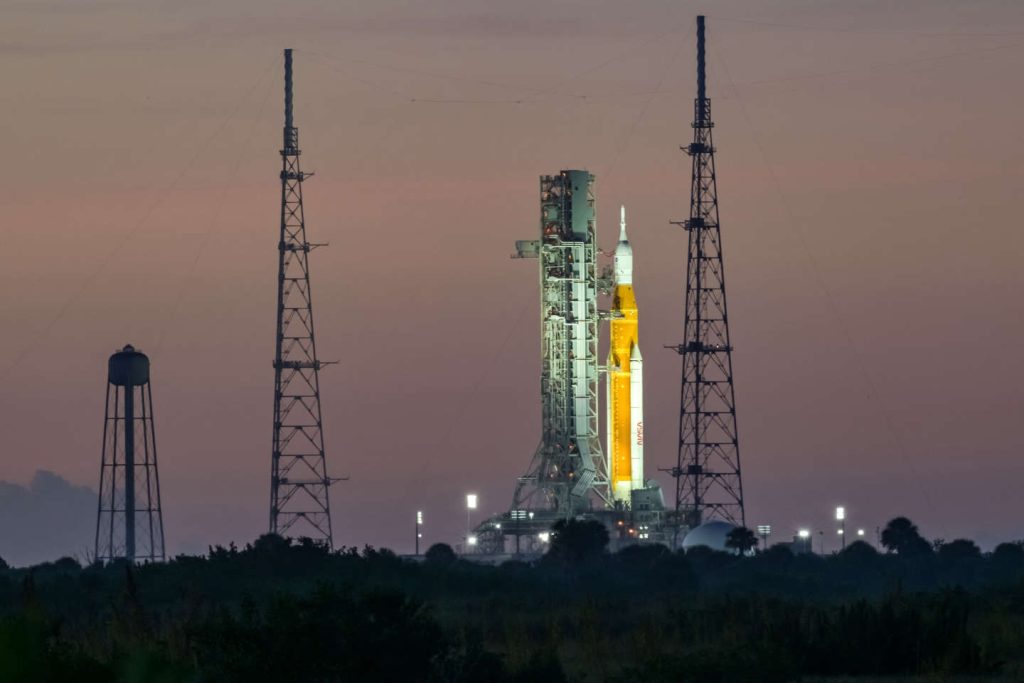
The launch of NASA’s massive rocket to the moon has been postponed again

The launch of NASA’s massive new moon rocket has been postponed again. During the final preparations, the teams attempted, Saturday 3 September, to solve the fuel leakage problem but were unsuccessful. A NASA commentator said in a video broadcast that launch manager Charlie Blackwell Thompson eventually made the decision to call off liftoffs from the Kennedy Space Center in Florida.
Launch of the orange and white SLS rocket which will be the first flight, It could happen on Monday or Tuesday, but NASA teams will have to analyze all the data before deciding on a new date. After Tuesday, no new launch possibilities will be possible before September 19, due to the positions of both the Earth and the Moon.
The mission, with no crew on board, is to launch the new Artemis program, fifty years after the last Apollo flight. Take off was scheduled for 2:17 p.m. local time (8:17 p.m. Paris time) from Launch Pad 39B at Kennedy Space Center, Florida, and remained possible for the next two hours, if necessary. Weather conditions were 60% favourable at the start of this shooting window, then it should gradually improve to 80%.
Shortly before 6 a.m. local time (12 p.m. Paris time), approval was given to begin filling the rocket’s tanks with its cryogenic fuel – in total, about three million liters of ultra-cold liquid hydrogen and oxygen.
But, a little more than an hour later, a leak was detected at the foot of the rocket, at the level of the tube through which hydrogen passes into the tank. The flow stopped while the teams searched for a solution.
Monday throughfirst attemptThe launch was called off at the last minute due to technical problems, especially with regard to engine cooling.
A starting point for a journey to Mars
The purpose of this unmanned mission, called Artemis-1, is to verify that the Orion capsule, located on top of the rocket, is safe enough to transport future astronauts. Thanks to this new ship, the US space agency intends to reconnect with distant human exploration, as the moon is a thousand times away from the International Space Station.
Above all, this time NASA intends to establish a permanent human presence there, in order to make it a springboard for a trip to Mars.
In the middle of a long weekend in the US, there were up to 400,000 people Expect to admire the take-off, especially from the surrounding beaches. It was many astronauts He also made the trip, including Frenchman Thomas Bisquet.
There are only a few hours left on the ground to witness this remarkable machine: the launch window opens at 8:17 PM. The weather is good and… https://t.co/Qfu707foS3
If you succeed, two minutes after take-off, the reinforcements He should have fallen in the Atlantic Ocean. Eight minutes later, the main stage was breaking off in turn. Then, about an hour and thirty minutes later, the final push from the upper stage was to put the capsule on its way to the moon, to reach it several days later. The trip is expected to last about six weeks. Orion will venture up to 64,000 kilometers behind the moon, farther than any other habitable spacecraft to date.
Journey of 2.1 million km
The main purpose of the Artemis-1 is to test the capsule’s heat shield, which is the largest of all. When entering the Earth’s atmosphere at a speed of 40,000 km / h, its temperature reaches 2,800 ° C. In total, the ship would have to travel about 2.1 million kilometers to land in the Pacific Ocean.
The full success of the mission will be a relief to NASA, which originally expected its 2017 launch of the SLS, and by the end of 2025 will have invested more than $90 billion in its new lunar program. .
The name Artemis was chosen after a female character, the twin sister of the Greek god Apollo – echoing the Apollo program, which sent only white men to the moon’s surface, between 1969 and 1972. This time, NASA wants to allow the first person of color and the first woman to walk on the moon. .
The next mission, Artemis-2, will take astronauts to the Moon in 2024, without landing there. This honor will be reserved for the Artemis-3 crew, in 2025 at the earliest. Then NASA wants to launch about one mission each year. It would then be a matter of building a space station in lunar orbit, a portico, and a lunar base.
There, NASA wants to test the technologies needed to send the first humans to Mars: new suits, a new craft, a potential use of lunar water…
According to NASA Administrator Bill Nelson, a round trip to the Red Planet aboard Orion, which will last several years, could be attempted at the end of the 2000s.

“Unapologetic pop culture trailblazer. Freelance troublemaker. Food guru. Alcohol fanatic. Gamer. Explorer. Thinker.”
